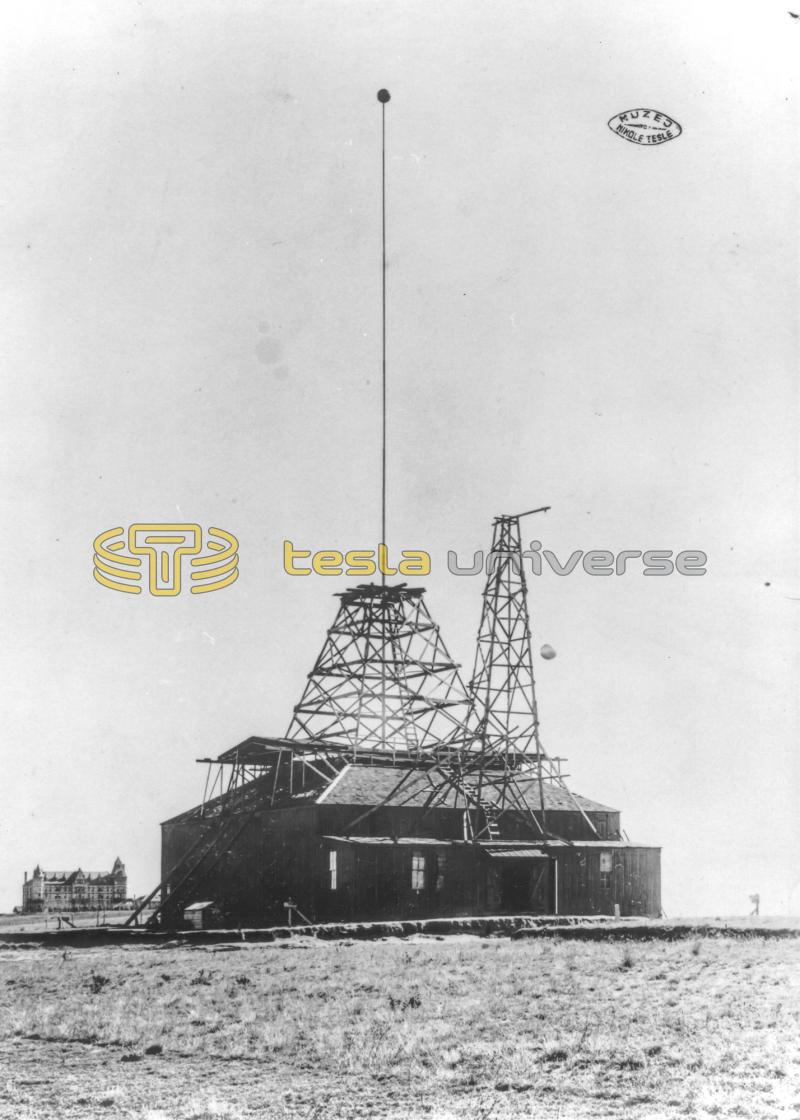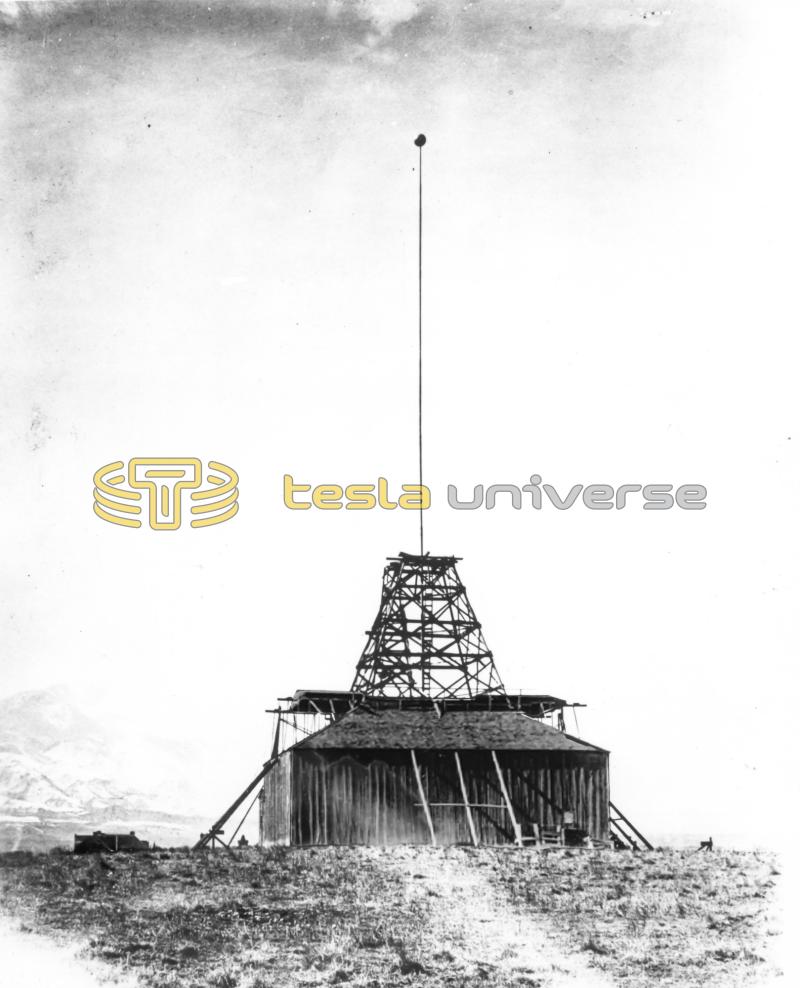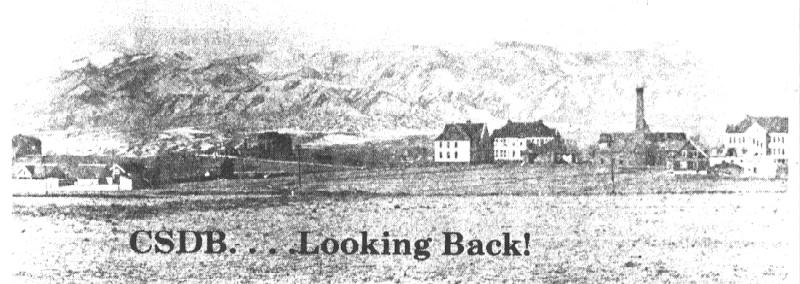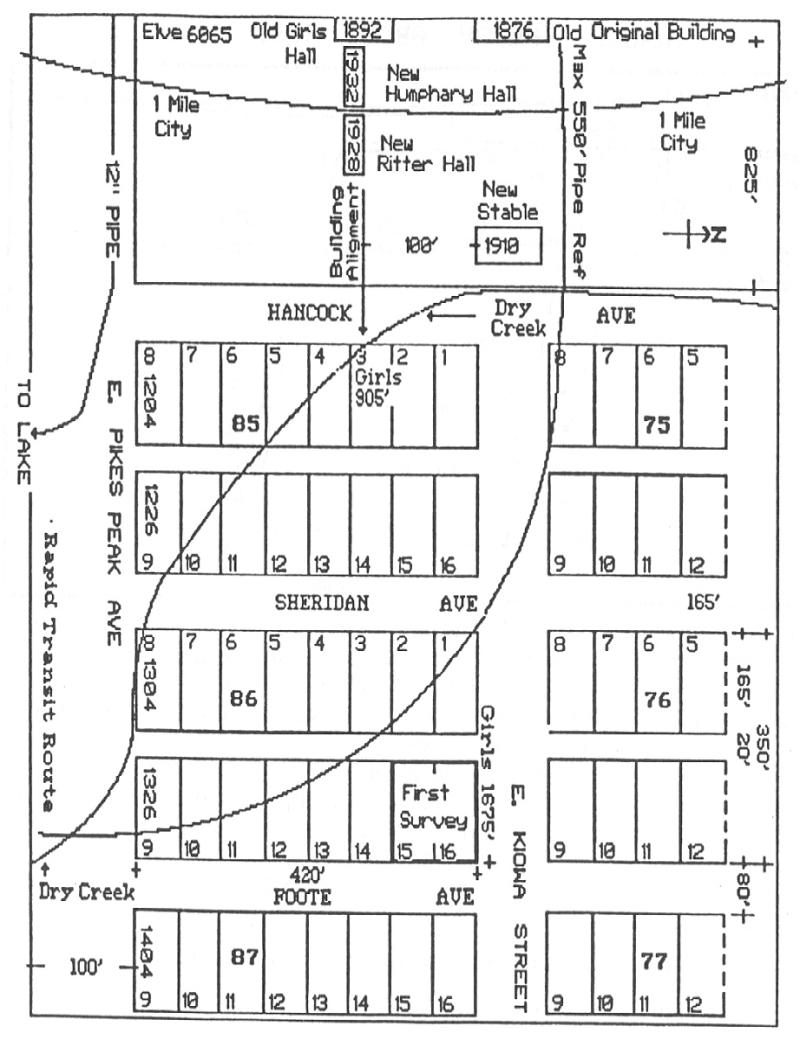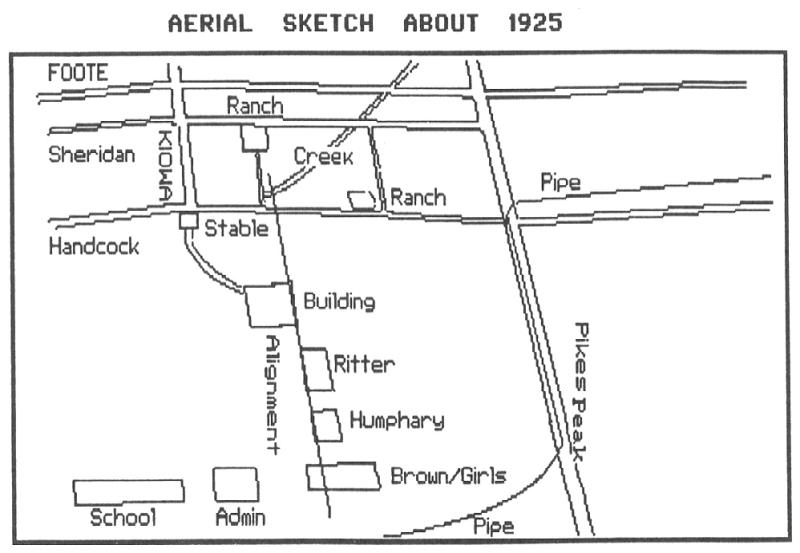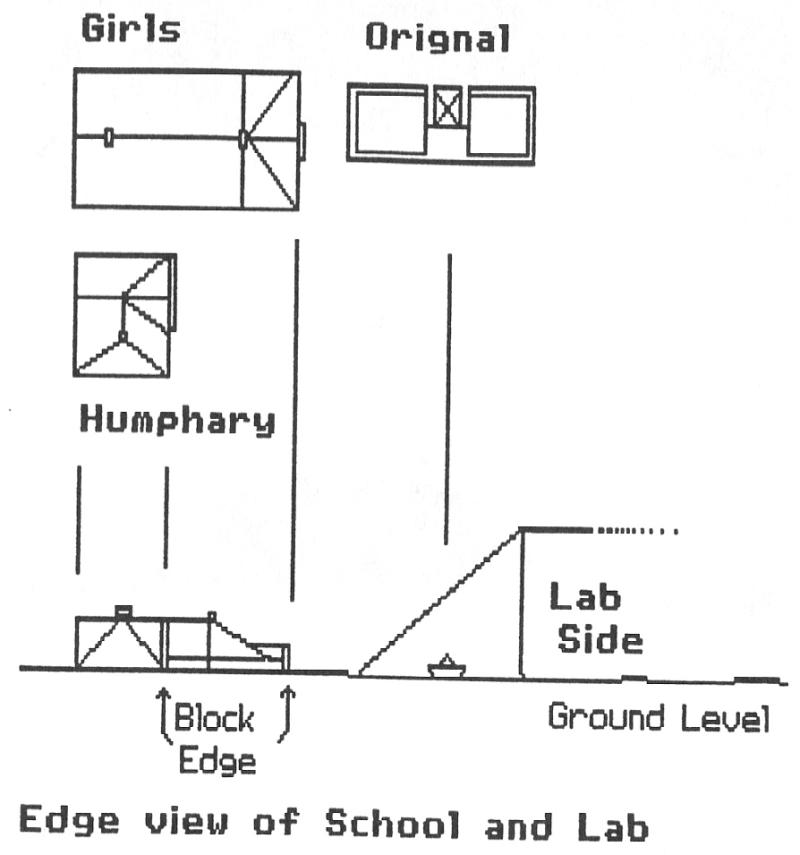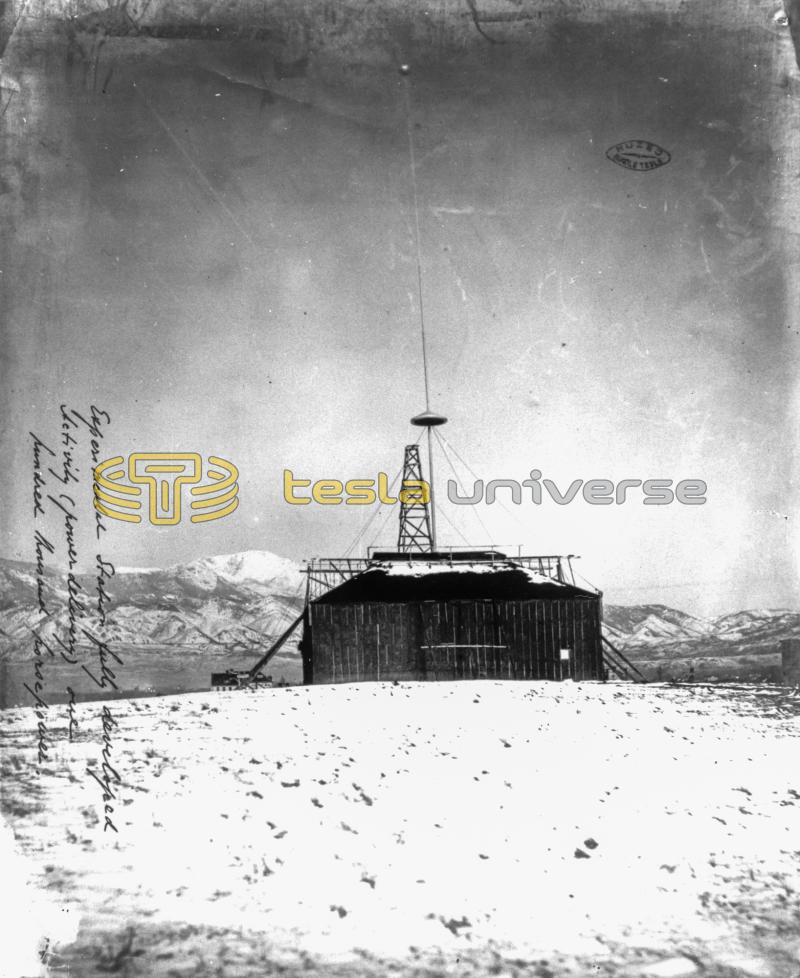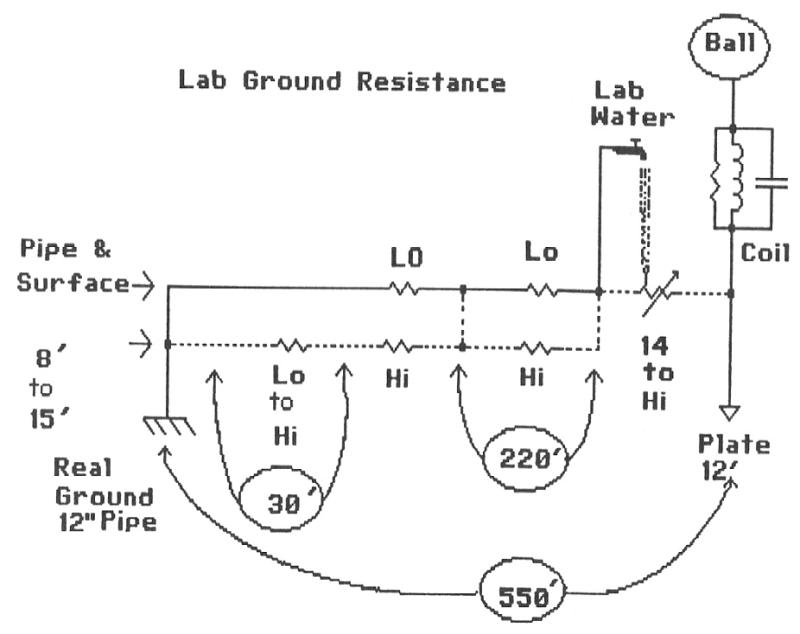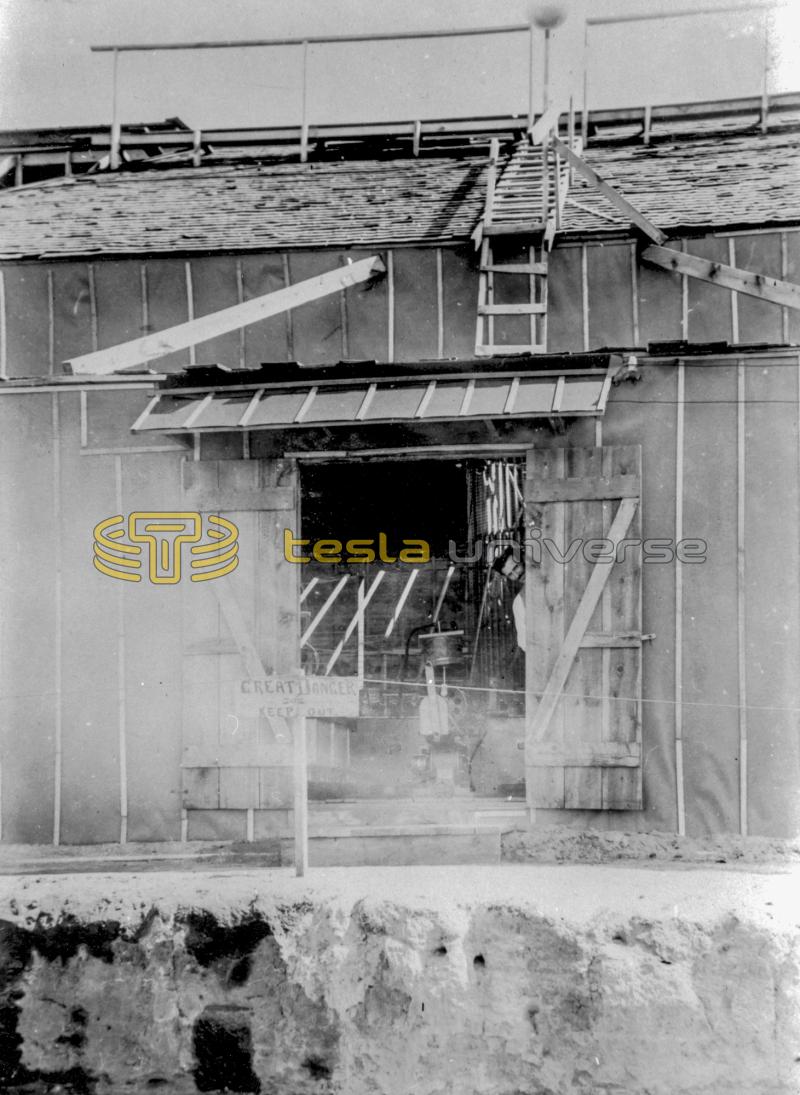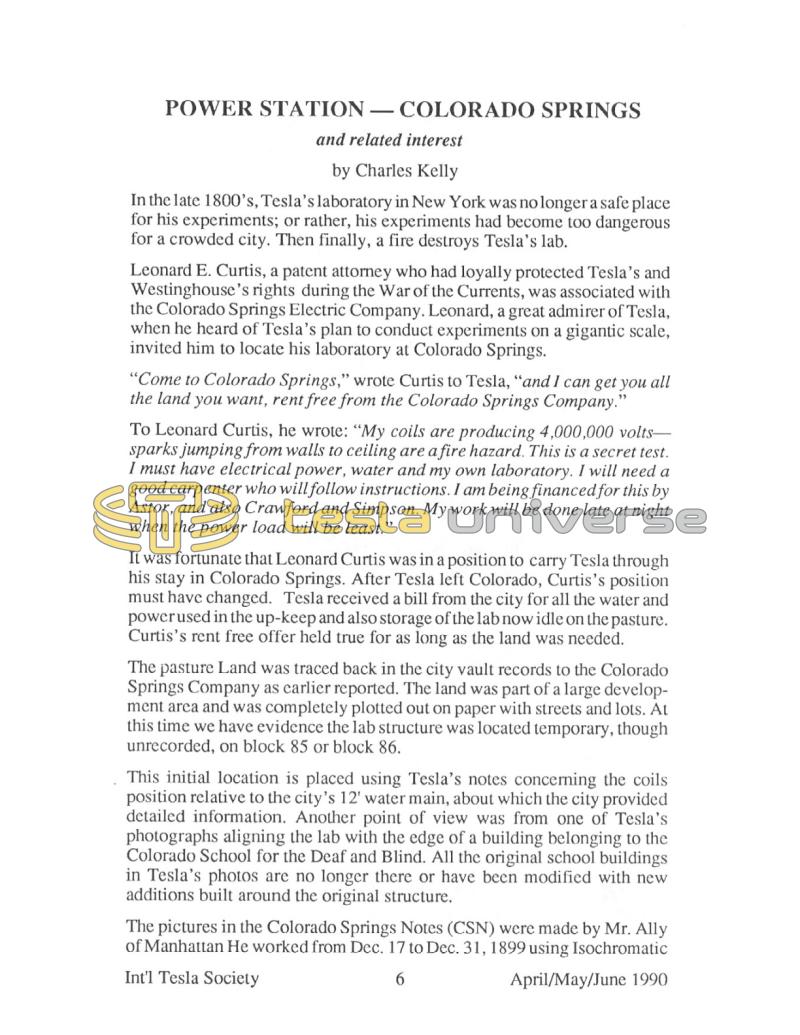
Nikola Tesla Articles
Power Station - Colorado Springs
In the late 1800's, Tesla's laboratory in New York was no longer a safe place for his experiments; or rather, his experiments had become too dangerous for a crowded city. Then finally, a fire destroys Tesla's lab.
Leonard E. Curtis, a patent attorney who had loyally protected Tesla's and Westinghouse's rights during the War of the Currents, was associated with the Colorado Springs Electric Company. Leonard, a great admirer of Tesla, when he heard of Tesla's plan to conduct experiments on a gigantic scale, invited him to locate his laboratory at Colorado Springs.
"Come to Colorado Springs," wrote Curtis to Tesla, "and I can get you all the land you want, rent-free from the Colorado Springs Company."
To Leonard Curtis, he wrote: "My coils are producing 4,000,000 volts - sparks jumping from walls to ceiling are a fire hazard. This is a secret test. I must have electrical power, water and my own laboratory. I will need a good carpenter who will follow instructions. I am being financed for this by Astor, and also Crawford and Simpson. My work will be done late at night when the power load will be least."
It was fortunate that Leonard Curtis was in a position to carry Tesla through his stay in Colorado Springs. After Tesla left Colorado, Curtis' position must have changed. Tesla received a bill from the city for all the water and power used in the up-keep and also storage of the lab now idle on the pasture. Curtis' rent-free offer held true for as long as the land was needed.
The pasture Land was traced back in the city vault records to the Colorado Springs Company as earlier reported. The land was part of a large development area and was completely plotted out on paper with streets and lots. At this time we have evidence the lab structure was located temporary, though unrecorded, on block 85 or block 86.
This initial location is placed using Tesla's notes concerning the coils position relative to the city's 12' water main, about which the city provided detailed information, Another point of view was from one of Tesla's photographs aligning the lab with the edge of a building belonging to the Colorado School for the Deaf and Blind. All the original school buildings in Tesla's photos are no longer there or have been modified with new additions built around the original structure.
The pictures in the Colorado Springs Notes (CSN) were made by Mr. Alley of Manhattan. He worked from Dec. 17 to Dec. 31, 1899 using Isochromatic 11" x 14" plates. The exposures were generally made during the late afternoon before sunset or by moon light. If the moon was 2/3 full, exposure times were in the range of 1h. 20 min. Coil exposures were multiples of 100 discharges followed by of ordinary arc lamp. The famous picture of Tesla sitting under the fiery coil was also a multiple exposure with him sitting safely in the chair during the 15 minute second exposure. If anyone knows the focal length of the lens that he used please let us know.
So, if you wander up to the hill with the photos found on pages 325, 364 of CS Notes, be careful not to mistake the Garage & Stable house at the West end of Kiowa St. built in 1910 for the Humphary Hall (1892-1932), with Girls Hall (1892-199_) located behind it. The photo looks like one building resembling the stable to some people.
Because the D&B school is key to many historical photographs and because of the confusion of original and present day structures, provided in the appendix is a run down of what has been compiled by the ITS to date concerning the school structures. The missing pieces are slowly being filled in as we go. If any serious studies are being done or have been done concerning the listed information, The ITS would be grateful for documented results. Those who are interested in developing the study are ask, kindly, to work with the ITS through a single effort as to not wear out our welcome and to remember the school is not funded to do research but has provided occasional help once or twice a year as a service to the community. The school has cooperated very fairly with the International Tesla Society and said they will continue to cooperate with our studies of the early historical area. We wish to publicly thank the school for the information contained here which corrected some incorrect earlier conclusions based on interpretation of Tesla's photographs.
The area around the lab site was not as altogether desolate as one might hear. The tract of land where Tesla placed his lab was rough pasture with some major roads on the sides. The Colorado Springs Rapid Transit Railway Company operated up Pikes Peak Avenue and turned North on Meade Avenue. Inez Hunt tell a story of Mr. Hugh D. Harper, later to become Police Chief of Colorado Springs, who was at the time a motorman on the street car that ran in that vicinity. He said the laboratory was an unforgettable sight but at that the time he wasn't interested enough to investigate. "I guess we all thought he was crazy," he commented.
The Street railway terminated in front of the printers home on Main Street (now called Union Blvd.) which was the outer city limits to the east. Just to the south is Memorial park, popular for the day activities of swimming or ice skating depending upon the month. The lake sported a concession stand, pavilion with a heated pool and a vaudeville show. A person could launch his own boat or for 10 cents passengers could ride a 40-foot steam launch. The pavilion burned down in 1906. The city stocked the lake with trout, black bass, perch, and crappie. A picture appeared in the Gazette Telegraph from late 1988 of the lake activities dated early 1900's. In the picture's background looking east on Main St. (Union Blvd.) was the Printers Home. Just to the right and forward was a strange building with a thin tower. Many people created a stir claiming that the tower was Tesla's lab. The truth is that the structure was part of the printers home complex or the R.R. termination area and the real lab site was to the left (north) 90 degrees and out of the view of the camera.
Recently a map was unexpectedly found in the micro film files of the Colorado Springs Library. The old map, dated about 1896, was one of streams, creeks and reservoirs in the area of the lab site. The map showed a creek snaking through plot 85 where Tesla might have built his lab, if you search the area you will not find a creek. In fact it would seem odd that water would be running across the hill. The area does give an illusion that the water would be running up hill and this could not be true because to the north the next hill is higher. This stream remained a mystery until a visit to the D&B School. There I saw an aerial picture of the school dated to the 20's or 30's.
In the back ground looking east is the old lab area site. If you looked closely you could see the scar of the old dried-up stream caused during heavy floods. This was an interesting find but it becomes even more so if you review some of the photos in the CSN (p.366,427). There you will find a rough rise 2 to 3 foot on the west side of the lab and about 8 to 10 feet out in front of the door. I would consider the feature a major flaw in placing the lab so close to it and I wonder why the decision was made. Maybe underground water was believed to exist. When all is considered, it does seem to be the storm wash shown in the photo and old map. The finding can be considered as a key to be plotted on the lab site map as to the relation of the front door to this feature.
To those who still wonder what the two little houses on the northeast and north side of the station are (CSN p.322,366). The one attached to the station is probably the wood shed to store fire wood for the stove heater. The second, as most older folks can guess, is the mens room (sorry, but no women worked there). If the site was ever dug up, however unlikely, there might be chemical traces and bottles, etc. found. I read about a new device that has been used to scan old cemeteries that can show hidden objects without disturbing the land. This might be useful if small objects register.
In several pictures can be seen a sign and less visible a thin rope or wire fence circling the lab. The firm warning was:
"KEEP OUT - GREAT DANGER"
A major problem most researchers have had with trying to extract positional distances from photographs in the CSN is that they were monographic, Good photographic surveys are taken with stereo-graphic pictures. Pictures with known optic that were calibrated. The resultant product is that distance can be extracted directly from the photograph of unknown objects.
All hope is not lost. There is still a method to ease this task. Because the lab dimensions can be basically established and the dimensions of a background object in the picture can be established. The distant between these objects can be established.
The technique is a zoom-up calculation. This is how it works. First, the length, width and height is established from the near object and a known object in the distance. The near object is the lab and the far object is the school window. It is best to blow up the photograph very large. Then overlay the picture with a reference scale to establish how many equal points per foot/scale. Once all the dimensions are referenced (baseline). The references are then compared to each other. In plain talk, a 18 foot high lab in the foreground will require a 4 foot high window in the distance to be enlarged by a linear amount until it is the same scale as the lab. The resultant distance will be equal to a final converted value in feet distance between the lab and the school. Then draw an arc on the plot map from the distant object. After several distant objects are measured and plotted there should be a common meeting of arcs indicating about where the lab should be. Other more complicated methods include trigonometry slope line calculations, if enough values of structure are known, this gets sticky with proper topography applied for non 90° baselines.
The Colorado Springs Notes (CSN) 1899-1900
The first official lab station note was dated in the journal, Colorado Springs June 15, 1899 and starts history with these words: "First Experiments in the station were made today."
The first task at hand for Tesla was firing up the 1/2-3/4 H.P. experiments with the new coil just installed. The Westinghouse Company transformer that Tesla mentions was probably the one rated at 50kw with a primary voltage 200/220V and secondary voltage 40, 50, and 60kv (CSN Sep. 13 p.185, p.418). The power feeding the lab was AC current and if you will note in the outside lab picture there are no wires seen in the air attached to the lab. The wires must have been under ground to prevent discharges from striking to them.
On the experiment Tesla states, "Sparks went over the lightning arresters instead of going to the ground of the arresters. This made it necessary to change the connection to the ground. By connecting the secondary to a water pipe, and leaving the ground of the arrester as before, the sparks ceased. This indicates a bad ground on the arresters. The latter work exceedingly well. The ground connection was made by driving in a gas pipe about 12 feet deep and gammoning coke around it. This is the usual way as here practised."
The first spark signaled a major problem with the Colorado Springs location that he later would not have in salt-based Wardenclyffe, if it had ever gone into full operation. The hill upon which Tesla built his station was dry and arid. The under lying sedimentary rock was mostly Pierre Shale and some Fox Hills sandstone. Tesla said: "The ground connection was made by driving ina gas pipe about 12 feet deep and gammoning coke around it. This is the usual way as here practiced." (CSN p.36,400,401)
This was the first reference to the general grounding method used, as there was very little knowledge of the science (reference to: "the usual") of grounding and the pipe was turn-of-century gas pipe. The coke gammoning was later replaced in industry with the use of salt and now other less harmful chemicals are used. Tesla continues, "The spark on the secondary was 5 inches long but very thick and noisy; indicates considerable capacity in the secondary. The weather was very stormy, hail, lightning." Even with wet conditions the ground was dry at the deep end of the ground rod.
The second ground reference was made the next day on June 16, 1899 when Tesla advances mankinds knowledge of ground rods. "Experiments were continued today. A new ground connection was made by digging a hole 12 feet deep and placing a plate of copper 20" X 20" on the bottom and spreading coke over it again, as customary. Water was kept constantly flowing upon the ground to moisten it and improve the connection but in spite of this the connection was still bad and to a remarkable degree. It is plain that the rocky formation and dryness is responsible and I think that the many cases of damage done by lightning here are partially to be attributed to poor earth connections. By keeping the water constantly running the resistance was finally reduced to 14 ohms between earth plate and the water main."
(note: I lost my reference where the CS notes say that the pipe used in the first ground was replaced with a heavy wire connected to a copper plate.)
Tesla next measured the ground waves of his new system around the station. "The action of the waves spreading through the ground was tested by a form of sensitive device later to be described and it was found that there was a strong vibration passing through the ground in and around the laboratory. The device was purposely unsensitive, to get an idea by comparison with former experience in this direction. It did not respond when placed close to the oscillator, but unconnected to ground or capacity, but responded 200 feet from the shop when connected to the ground with one terminal. It responded well also along a water main, as far as it reached, although it was connected to the ground fairly well."
The water pipe is referred to as the "water main" and is a common water pipe of the age used. Pipes referenced are equally called 'mains'. The 200 foot reference is 'gray' as to what other, if any device or spigot might have been present. The reference of "as far as it reached" refers to the fact that the pipe was laying across the pasture ground and then terminates under the earth as it nears an area of Pikes Peak Avenue The exact location where the pipe enters (under ground) Pikes Peak A venue was not documented by the water utilities as they say, "it was not a city connection but a private job." This connection is a major key to the exact location of the lab 550 feet from the 12' water main connection. It is also possible that the pipe turned west and went under Hancock and tapped in to the farm house on the corner lot of Deaf and Blind School.
"Evidently the soil lets the water run through easily and being extremely dry as a rule it is very difficult to make a good connection. This may prove troublesome. The water will have to be kept flowing continuously. The high resistance explains the difficulty, from a few days before, of getting the proper vibration of the secondary. The first good ground was evidently at the point where the water main feeding the laboratory connected to the big main underground and this was several hundreds of feet away (sec CSN Aug. 6, Distance from ground-plate to end of main exactly 550 feet). This additional length in the secondary wire which became thus too long for the quarter of the wave as calculated. The nearest connection to earth was as measured about 260 feet away (object not identified other then maybe a spigot) arid even this one was doubtful.
The bottom wire length of the coil was extended the additional length to connect with the sites 12 inch water main feeding prospect lake located under Pikes Peak avenue 550 feet away."
Tesla, makes important reference that many researchers fail to consider when evaluating the station coil operation and vibration pattern signature surrounding the lab site. The real ground node. Not only was the length of conductor important but the angle of pipe is physically 90 degrees to the 150 foot mast (height, CSN p.192,227,259,422 and C=464.8cm). The coil is now center driving a physical 90 degree transmission antenna and up to 550 feet from the true earth node. Tesla's drawings show the commonly thought tower electrical pattern; but was this the real and true pattern. Is not the pattern now more directional, due to the ground pipe. The pattern seems now to be very unique in both horizontal and vertical polarity of surface and internal earth propagational waves. Remember Tesla said that this earth-ionosphere device is not Hertzian (CSN p.19,62) and although the coil can operate at high frequency the propagated wave claimed is very much Extra Low Frequency (ELF), if operating thru earth media as Tesla claimed.
The Colorado City Utilities provided from their old vault information concerning the 12 inch water main described by Tesla. The pipe comes south across the west side of the state owned Deaf and Blind School and turns east under Pikes Peak Avenue to about a half block east of Hancock Avenue where the alley meets. There the large pipe turns 90 degrees and dumps into Prospect Lake to the south. This pipe was the only pipe in the area in 1899 and remained so until 1907 when two valves (records referenced 57 and 58) were installed, closing off the no longer used lake arm and connecting a new 12 inch main coming south down the alley between Hancock and Sheridan, and passing nearly under Tesla's lab. This would have produced a great ground connection for the coil eight years earlier.
Publication Clippings
A curious article appeared in the paper two years after Tesla went back to N.Y.; On Oct. 30, 1903 Colorado Springs Gazette states:
TESLA PLANNING TO COME HERE.
Water Commissioner Received Information That Scientist Will Soon Arrive In Colorado Springs.
Water Commissioner E.W. Davis has received information to the effect that Nikola Tesla, the celebrated electrical experimentist and inventor will be in Colorado Springs within a few weeks.
The experimental station erected by Mr. Tesla on Knob Hill about two years ago, is still in as good condition as it was when he left it, and if he comes here he may decide to conduct further experiments. The station here has been in charge of two watchmen ever since Mr. Tesla returned to the east and everything has been kept in perfect trim ready for his return.
The station here was used by Mr. Tesla in his wireless telegraphy experiments. (Oct. 30, p 1 Col. 7)
Why was the water commissioner told and how did the city calculate the water usage for the bill sent to Tesla? Did the city meter the station or just apply a standard rate per month?
On Apr. 6, 1904, Colorado Springs Gazette states:
TESLA IS SUED
Is Asked to Pay for Electricity Furnished
Experimental Station He Abandoned.
Nikola Tesla, the famous electrical expert, whose experiment station on Knob Hill has furnished material for query on the part of visitors here during the past few years, is the defendant in a suit instituted in the county court yesterday by the Colorado Springs Electrical Company. The suit is brought to secure judgement for $180, said to be due for electrical energy furnished Tesla from June 1, 1904 to March 23, 1904. Tesla himself has not been in Colorado Springs for three years and the sheriff's office is trying to locate him for the service of the papers.
Tesla erected his experiment station for the purpose of perfecting his apparatus for the transmission of telegraphic message without wires. Recently, Tesla was sent a bill by the city for water furnished the station. In his novel reply he said inasmuch as he graced this city with his presence and had erected an experiment station here, he considered that the city should donate all the water used at the station.
On July 2, 1904 Colorado Springs Gazette states:
TESLA'S ELECTRICAL STATION IS SOLD FOR VALUE OF LUMBER.
The Nikola Tesla experimental electrical station, near the Deaf and Blind School east of the city, has been abandoned. The building still stands there but even that trace of the visit of the great electrician is soon to disappear, for the station has been sold.
Five years ago last May, Tesla decided to construct this station and did so. He stated that he intended to carry on wireless telegraphy experiments from the summit of Pike's Peak to this station. So far as can be learned he never really carried on any important experiments here. He left this city shortly after erecting his station and has not returned since. He was recently sued for an electricity bill, for power furnished by the Colorado Springs Electrical Company. He failed to answer the summons either personally or by an attorney and his property was advertised for sale. He later sent the sheriff enough money to cancel the bill and the station again became his property.
Supposedly on his order his property has been sold. That is all but the apparatus. This has been stored and will probably be shipped to Tesla in the near future.
The building has been sold to C. E. Maddocks, who erecting a new house in lvywild and will use the lumber in its construction or for some other purpose about his property, it is understood. The piping has been sold to St. John Bros. (Colorado Springs Gazette p. 5 Col. 3)."
On Mar. 10, 1906 Colorado Springs Gazette states:
TESLA'S FIXTURES IN SHERIFF'S SALE.
Famous Inventor's Para-Phernalia To Be Sold To Satisfy A Judgment For $928
The sale of a quantity of personal property belonging to Nikola Tesla, the famous electric inventor, to satisfy an execution issued of county court in favor of C.J. Duffner, for $928.75 and costs, was scheduled to be held yesterday but was postponed by consent until 10 o'clock on the morning of March 22. The property held by the sheriff consists of 27 cases of goods and 10 coil of copper wire, all of which was levied upon in Tesla's experimental station on Knob Hill. (P 5, Col 3)
ELEVATED STORAGE OF ENERGY
Tesla's knowledge of charging an elevated sphere as used at Colorado Springs and Wardenclyffe was the most advanced. Method of Utilizing Radiant Energy patent No. 685,958 filed Mar. 21, 1901 showed how to transmit energy through the air to a target. Tesla also published detailed knowledge of static laws utilized in Van de graaff generators.
At Wardenclyffe the 30 inch copper sphere was increased to tens of feet. This followed Tesla's return to N.Y. from Colorado Springs. The now famous Apparatus for transmitting Electrical Energy (patent No. 1,119,732) shows Tesla's direction that the sphere can be charged or biased (charge means DC/static volts; a high or low Frequency resonant ripple or xray may be employed) to a great quantity of stored electric energy. With high frequency, the normally large capacitance is held low enough to allow some value of high frequency to exist (a difficult balancing of design). Also, having a physical surface area of large radius of curvature will reduce the surface area field (surface-density Q=E/A) thus avoiding discharge to near objects or escaping to the air, if desired. As an example: a surface charge can be shown with a one square foot metal plate impressed with 1,000 volts of DC energy (1,000 volts per sq/ft of static charge). If the plate is increased to ten square feet the 1,000 volts will spread out evenly across the plate and the resulting surface charge will reduce to 100 volts per sq/ft. But the amount of energy (charge of electrons) remains the same on the plate (positive or negative). This is how non-grounded conductive static floors work in hospitals and industry (They require a minimum of 500 Sq. fl. of surface area by safety regulation).
This is also analogous to a mass of water raised to a height (static charge) or to blowing up a balloon with low or very high frequency of small breaths to a very high pressure (voltage). But the frequency of breaths must be resonant (timed) to both the balloon and your lungs, with each fresh impulse it will be charged to a higher potential. Thus, small impulses may be accumulated. Once the elevated mass is charged to a large volume of energy and set into large swinging motions, (ELF). The amount of energy moving up and down the tower can be very great (large amperage) and capable of work (horse power). Refer to the many high and low frequency lab experiments with elevated capacity mass or terminated mass loading of light bulbs with only one wire.
High Frequency can produce global ELF waves world wide as Tesla explains one method: "by impressing upon the earth two or more oscillations of different wave length. A resultant stationary wave may be made to travel slowly over the globe, and thus a great variety of useful effects may be produced. (Tesla is referring to nonpower transmission concepts such as ship navigation) As the main object for which the apparatus is designed is to produce a current of excessively-high potential. The frequency of the currents is in a large measure arbitrary, for if the potential be sufficiently high and the terminals of the coil be maintained at the proper elevation where the atmosphere is rarefied the stratum of air will serve as a conducting medium for the current produced and the latter will be transmitted through the air, with, it may be, even less resistance than through an ordinary conductor." (Patents p.320).
Rarefied transmission might be easily the case at 6,000 ft. Colorado Springs; but what of higher pressure at sea level with conductive fog to bleed off charge. The bleed must be controlled in rate as charge will act like evaporating water off an object. This is why humidity is useful in controlling static electricity, it causes dry insulative air to conduct. With high quantities of energy and low surface electrical field you could operate in the rain with little or no little unwanted discharge, even to a close flying blimp as often shown in art work.
The inquisitive investigator can observe a very 'crude' method of a single low frequency terrestrial source of oscillation preforming work. Pardon the example, but nature demonstrates this on windy days. Just glance in your toilet and you will see the water going up and down in rhythmic oscillations, and at times standing waves can be observed. A mini Tesla effect. I would suggest that you first lock the door before you intensely stare into your bowl.
Tesla states that there are three requirements essential to the establishment of the resonating condition (of the earth).
"First. The earth's diameter passing through the pole should be an odd multiple of the quarter wave length that is, of the ratio between the velocity of light - and four times the frequency of the current.
Second. It is necessary to employ oscillations in which the rate of radiation of energy into space in the form of Hertzian or electromagnetic wave is very small. To give an idea, I would say that the frequency should be smaller than twenty thousand per second, though shorter waves might be more practicable. The lowest frequency would appear to be six per second, in which case there will be but one node, at or near the ground-plate. With oscillations still slower the earth, strictly speaking, will not resonate, but simply act as a capacity, and the variation of potential will be more or less uniform over its entire surface.
Third. The most essential requirement is, however, that irrespective of frequency the wave or wave-train should continue for a certain interval of time, which I have estimated to be not less than one-twelfth or probably 0.08484 of a second and which is taken in passing to and returning from the region diametrically opposite the pole over the earth's surface with a mean velocity of about four hundred and seventy-one thousand two hundred and forty kilometers per second.
"For the present it will be sufficient to state that the planet behaves like a perfectly smooth or polished conductor of inappreciable resistance with capacity and self induction uniformly distributed along the axis of symmetry of wave propagation and transmitting slow electrical oscillations without sensible distortion and attenuation." Slow electrical oscillations can qualify as earth resonant ELF waves. (patent #787,412 p.400)
APPENDIX
Colorado Springs School for the Deaf and the Blind
(est. 1874) is located on Bristol Heights Addition west of Knob Hill.
Knob Hill was not named on plot records I have and possibly a pre-local reference to the large track of land owned by C.S.C. Much of the information contain here is from The schools publication The Colorado Index (est. Jan.31 1875- Present) from an article 1980, CSDB ... Looking Back by Ann G. Williams. The Colorado Springs Library, interviews/photos with persons connected with the school, and the Colorado Springs City records.
STRUCTURAL LISTING:
- Original Building (1876-1923) Sandstone building was expanded.in all possible directions; Now site of argo building.
- Original barn (187_-1910); shown in 1889 photo
- First laundry Building (187_-1923);The Tall stack shown in 1889 photo about the center of campus. Replaced in general by the Argo building complex.
- Hospital (1905-present); Original is shown in 1889 photo. It was replaced as was by a new building but no date is noted.
- First School Building (1889-1950); "Old School Building" - Girls Hall (1892-192_); Brown Hall was built around it..
- Humphary Hall (1894-1932), vocational building; present site of George West Hall.
- Small building located by the original barn was not listed here; but is seen in the 1889 photo with the barn.
- Sloyd Building (1900-present).
- Administration Building (1906-present)
- ASA T. Johns Hall (1912-present).
- Argo Building (1923-present); First called Original Building was expanded in all possible ways; A small record found that was a bit confusing but in time maybe it will be explained, "Jones Hall (originally named Argo Hall). Argo Hall is what's contained on the plot maps today; but to the north today is a Jones Hall.
- Steam Plant (1923-present)
- Brown HaJl (192_-present);Built around the original Girls Hall. The exact date replaced not found.
- Ritter Hall (1928-present)
- George West Hall (1932-present); Site of original Humphary Hall.
- Palmer Hall (1915-present ?);I lost my notes on this building; but it is now not found named on plots. I believe I was told it was renamed or another built around it.
- Industrial Building (1915-present)
- Garage and Stable, new barn, (1910-present)
- Ranch (190_- __ )- pre 1919; 3/4 mi east of campus to provide milk and also raised a number of animals.
- Boys Dorm
OTHER STRUCTURES SEEN IN PHOTOGRAPHS
- Bellevue Sanitarium (__ - __);Due south of the school. The land was acquired by the D&B school in 1919, but lent to the Red Cross in 1920 during a great flu.; Shown in 1890 photos.
- Saint Frances Hospital (__ - __) or what is now SFH; Shown in 1890 photos.
- Printers Home (18__-present);
ACKNOWLEDGEMENTS
Edd Conley; Ted McKee; Connie Stevens
Colorado Springs Library; Colorado Springs Dept. of Utilities Water Engineering
Books
Prodigal Genius, John J. O'Neill; Lightning in His Hand, Inez Hunt and Wanetta W. Draper; Tesla Said, John T. Ratzlaff; Colorado Springs Notes, Tesla Museum, Beograd Dr. Marincic; Gazette Telegraph
